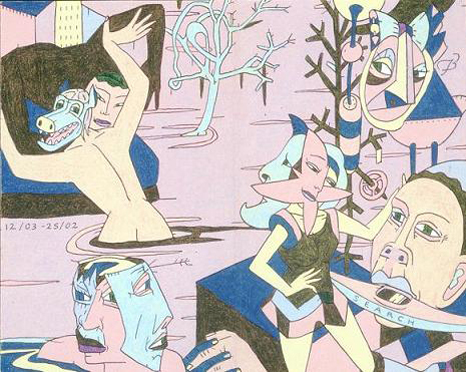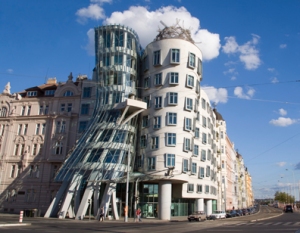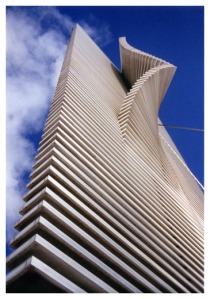- Antimodernist
- Revision of modernist premises
- A philosophical movement away from the viewpoint of modernism
- A tendency in contemporary culture characterized by the problem of objective truth and inherent suspicion towards global cultural narrative or meta-narrative
- A phrase commonly used to describe the human era of the 20th century.
- An intentional departure from modernist approaches that had previously been dominant
- One of the most important aspects of the Post-Modern mindset is that the perceiving subject cannot be taken out of the equation.

Francis Berry, Whimsical Entropy: Postmodern Elegy, Watercolour, 14" x 20", 2006
2. Use a quote by Witcombe (2000) to define the Post-Modern artist.
“The post-modern artist is reflective in that he/she is self-aware and consciously involved in a process of thinking about him/herself and society in a deconstructive manner, ‘damasking’ pretentions, becoming aware of his/her cultural self in history, and accelerating the process of self-consciousness.”

Postmodern Western art by contemporary artist Francis Berry, postmodern painter
3. Use the grid on pages 42 and 43 to summarize the list of the features of Post-Modernity.
"Postmodernism is of interest to a wide range of artistic practices and social science and humanities disciplines because it directs our attention to changes taking place in contemporary culture. These can be understood in terms of (1) the artistic, intellectual and academic fields (changes in modes of theorization, presentation and dissemination of work which cannot be detached from changes in specific competitive struggles occurring in particular fields); (2) changes in the broader cultural sphere involving modes of production, consumtion and circulation of symbolic goods which can be related to broader shifts in the balance of power and interdependencies between groups and class fractions on both inter- and intra-societal levels; (3) changes in the everyday practices and experiences of different groups, who as a result of some of the processes referred to above, may be using regimes of signification in different ways and developing new means of orientation and identity structures."


5.Research Chinese artist Ai Weiwei's 'Han Dynasty Urn with Coca-Cola logo'(1994) in order to say what features of the work are Post-Modern.
 '
'Han Dynasty Urn with Coca-Cola logo'(1994), Ai Weiwei
Ai Weiwei has masterminded some of the most powerful icons of today: the National Stadium, the “Han Dynasty Urn with Coca Cola Logo,” and his unpretentious, minimalist building style of grey-brick has revolutionized contemporary Chinese architecture. He has challenged his country's political authority and literally destroyed its cultural traditions. He paints “the Coca-Cola logo’’ on a 2000 year old Dynasty urn. As one of China's leading contemporary artists, Ai Weiwei has challenged his country's political authority and literally destroyed its cultural traditions. As an architect, he has had a key role in designing one of the most strikingly visible symbols of contemporary China -- the stadium now rising for the 2008 Beijing Olympics.

2008 “Birdnest” Olympic Stadium Construction Site
6. Research British artist Banksy's street art, and analyze the following two works by the artistto discuss how each work can be defined at Post-Modern.

Los Angeles (2008), Banksy
Banksy is a pseudonymous England based graffiti artist, political activist, film director and painter. His satirical street art and subversive epigrams combine irreverent dark humour with graffiti done in a distinctive stencilling technique. Such artistic works of political and social commentary have been featured on streets, walls, and bridges of cities throughout the world. Banksy is very political with his pieces and isn’t scared to express his ideas, which again are very post-modern like. As we can see in this artwork, he’s put up a caveman carrying a bone in one hand a tray with a burger, fries, and a milkshake in the other.

http://www.news.cornell.edu/stories/Nov06/Chinese.artist.dea.html
http://www.arthurimiller.com/journalism/the-worlds-of-ai-weiwei/
http://en.wikipedia.org/wiki/Banksy
http://en.wikipedia.org/wiki/Ai_Weiwei
I read your article I understand that As one of China's leading contemporary artists, Ai Weiwei has challenged his country's political authority and literally destroyed its cultural traditions.This is the distinctive feature of post-modern. Post-modernism against all authority and rank, authority and against the idea of power and discourse theory, promotion of open and democratic atmosphere and culture to share, against all monopolies, tyranny and hegemony. Ai Weiwei questioned the government, the courage to face any authority to use the deconstruction of the traditional way to create a modern,.His work with subversion, the reconstruction of traditional cultural symbols to express the digestion of authority and tradition and neglect.Bansky has made several politically related comments in his various books. 'Flower riot' Bansky shows The bouquet of flowers symbolises the idea of spreading peace, thus being a sort of irony which is an example of post modern art.
ReplyDelete